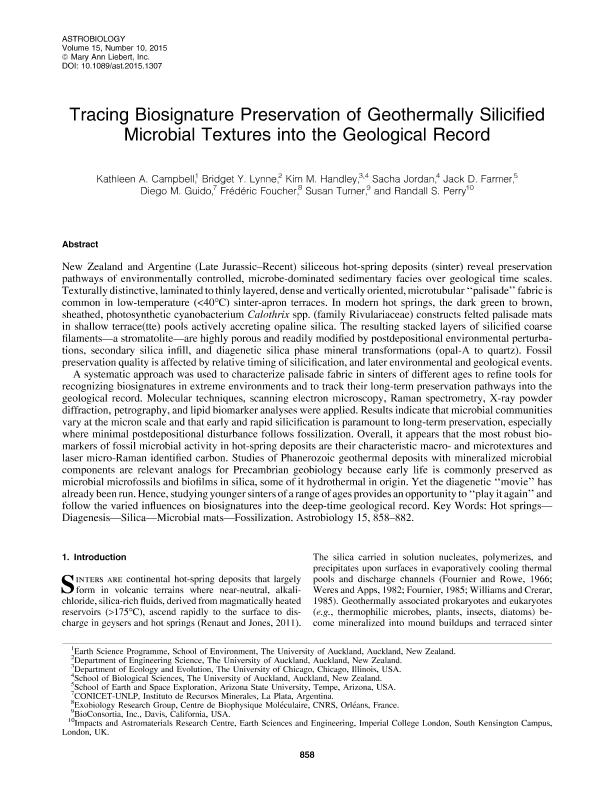Mostrar el registro sencillo del ítem
dc.contributor.author
Campbell, Kathleen

dc.contributor.author
Lynne, Bridget Y.
dc.contributor.author
Handley, Kim M.
dc.contributor.author
Jordan, Sacha
dc.contributor.author
Farmer, Jack D.
dc.contributor.author
Guido, Diego Martin

dc.contributor.author
Foucher, Frédéric
dc.contributor.author
Turner, Susan
dc.contributor.author
Perry, Randall S.
dc.date.available
2018-07-31T18:58:34Z
dc.date.issued
2015-10
dc.identifier.citation
Campbell, Kathleen; Lynne, Bridget Y.; Handley, Kim M.; Jordan, Sacha; Farmer, Jack D.; et al.; Tracing Biosignature Preservation of Geothermally Silicified Microbial Textures into the Geological Record; Mary Ann Liebert; Astrobiology; 15; 10; 10-2015; 858-882
dc.identifier.issn
1531-1074
dc.identifier.uri
http://hdl.handle.net/11336/53632
dc.description.abstract
New Zealand and Argentine (Late Jurassic-Recent) siliceous hot-spring deposits (sinter) reveal preservation pathways of environmentally controlled, microbe-dominated sedimentary facies over geological time scales. Texturally distinctive, laminated to thinly layered, dense and vertically oriented, microtubular "palisade" fabric is common in low-temperature (<40°C) sinter-apron terraces. In modern hot springs, the dark green to brown, sheathed, photosynthetic cyanobacterium Calothrix spp. (family Rivulariaceae) constructs felted palisade mats in shallow terrace(tte) pools actively accreting opaline silica. The resulting stacked layers of silicified coarse filaments a stromatolite are highly porous and readily modified by postdepositional environmental perturbations, secondary silica infill, and diagenetic silica phase mineral transformations (opal-A to quartz). Fossil preservation quality is affected by relative timing of silicification, and later environmental and geological events. A systematic approach was used to characterize palisade fabric in sinters of different ages to refine tools for recognizing biosignatures in extreme environments and to track their long-term preservation pathways into the geological record. Molecular techniques, scanning electron microscopy, Raman spectrometry, X-ray powder diffraction, petrography, and lipid biomarker analyses were applied. Results indicate that microbial communities vary at the micron scale and that early and rapid silicification is paramount to long-term preservation, especially where minimal postdepositional disturbance follows fossilization. Overall, it appears that the most robust biomarkers of fossil microbial activity in hot-spring deposits are their characteristic macro-and microtextures and laser micro-Raman identified carbon. Studies of Phanerozoic geothermal deposits with mineralized microbial components are relevant analogs for Precambrian geobiology because early life is commonly preserved as microbial microfossils and biofilms in silica, some of it hydrothermal in origin. Yet the diagenetic "movie" has already been run. Hence, studying younger sinters of a range of ages provides an opportunity to "play it again" and follow the varied influences on biosignatures into the deep-time geological record.
dc.format
application/pdf
dc.language.iso
eng
dc.publisher
Mary Ann Liebert

dc.rights
info:eu-repo/semantics/openAccess
dc.rights.uri
https://creativecommons.org/licenses/by-nc-sa/2.5/ar/
dc.subject
Diagenesis
dc.subject
Fossilization. Astrobiology 15
dc.subject
Hot Springs
dc.subject
Microbial Mats
dc.subject
Silica
dc.subject.classification
Paleontología

dc.subject.classification
Ciencias de la Tierra y relacionadas con el Medio Ambiente

dc.subject.classification
CIENCIAS NATURALES Y EXACTAS

dc.title
Tracing Biosignature Preservation of Geothermally Silicified Microbial Textures into the Geological Record
dc.type
info:eu-repo/semantics/article
dc.type
info:ar-repo/semantics/artículo
dc.type
info:eu-repo/semantics/publishedVersion
dc.date.updated
2018-07-31T17:19:18Z
dc.journal.volume
15
dc.journal.number
10
dc.journal.pagination
858-882
dc.journal.pais
Estados Unidos

dc.description.fil
Fil: Campbell, Kathleen. The University of Auckland; Nueva Zelanda
dc.description.fil
Fil: Lynne, Bridget Y.. The University of Auckland; Nueva Zelanda
dc.description.fil
Fil: Handley, Kim M.. The University of Auckland; Nueva Zelanda. University of Chicago; Estados Unidos
dc.description.fil
Fil: Jordan, Sacha. The University of Auckland; Nueva Zelanda
dc.description.fil
Fil: Farmer, Jack D.. Arizona State University; Estados Unidos
dc.description.fil
Fil: Guido, Diego Martin. Universidad Nacional de la Plata. Facultad de Ciencias Naturales y Museo. Instituto de Recursos Minerales. Provincia de Buenos Aires. Gobernación. Comisión de Investigaciones Científicas. Instituto de Recursos Minerales; Argentina. Consejo Nacional de Investigaciones Científicas y Técnicas; Argentina
dc.description.fil
Fil: Foucher, Frédéric. Centre National de la Recherche Scientifique; Francia
dc.description.fil
Fil: Turner, Susan. BioConsortia; Estados Unidos
dc.description.fil
Fil: Perry, Randall S.. Imperial College London; Reino Unido
dc.journal.title
Astrobiology

dc.relation.alternativeid
info:eu-repo/semantics/altIdentifier/doi/http://dx.doi.org/10.1089/ast.2015.1307
dc.relation.alternativeid
info:eu-repo/semantics/altIdentifier/url/https://www.liebertpub.com/doi/10.1089/ast.2015.1307
Archivos asociados
